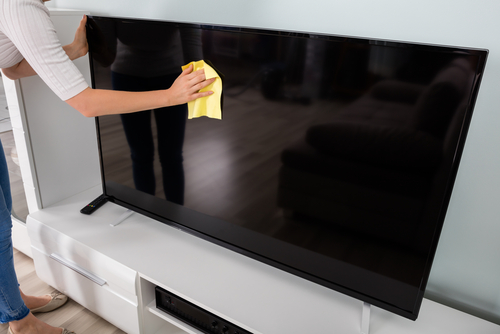Cleaning your television regularly will help to extend its lifespan and ensure you get to watch your favourite shows without dust, fingerprints or streaks getting in the way. Thankfully, compared to other items around the house, cleaning a TV requires only few products and minimal elbow grease. Follow this Canstar Blue guide to learn everything you need to know about cleaning a TV screen.
What’s in this guide?
Why should I clean my TV screen?

Televisions can be expensive items, so it’s important that you take great care of them. Dirt, dust and bacteria are likely to build up on your TV screen over time, and regular cleaning will help you stay on top of this. Cleaning your television will make sure that you’re getting the most out of your appliance, prolonging its lifespan and maximising performance, allowing you to enjoy a clearer picture.
How often should I clean my TV?
You should clean your television, speaker system and remote every week to avoid a monstrous buildup of dust and greasy marks that can make it more difficult to clean later on. Fortunately, the cleaning process is simple and shouldn’t take up too much of your time.
How to clean a TV screen
The cardinal rule here is to never spray any liquids or foams on the actual TV, as it can damage its display or even cause an electrical fire. It’s also important to read the manufacturer’s instruction manual before attempting anything. Here are four easy steps you can follow to maintain your LCD, LED, OLED, or plasma screen television:
- Unplug the TV and wait until it has completely cooled down.
- Clean the frame with a dry, soft, lint-free cloth.
- Wipe the TV screen with a microfiber cloth. For marks that won’t budge, spray a small amount of screen cleaning solution onto the cloth and gently go over the area again. Be careful, streaks are caused by applying too much liquid onto your cloth.
- Wait a few minutes for the TV screen to air dry before plugging the cables back in.
How to clean fingerprints off a TV screen
Fingerprints can be challenging to remove from a TV screen. Follow these steps to clean fingerprints off your TV screen:
- Unplug the TV and wait until it has completely cooled down.
- Apply a small amount of screen cleaning solution to a microfiber cloth.
- Wipe away any fingerprint marks or smudges on your screen, ensuring you move in a gentle back-and-forth motion.
- Add a small amount of warm water to the microfiber cloth and gently wipe again to remove any persistent fingerprint marks.
TV screen cleaner
There are a number of either household or commercial items that you can use to effectively clean your TV screen. The best option is to purchase specific electronic screen cleaning solutions or wipes. These screen cleaners generally cost around $10 and can be purchased from most electronics stores. If you don’t have access to a store-bought cleaning solution, the next best bet is to create your own concoction. You can do so by combining equal parts white vinegar and water.
Cleaning your TV screen
Cleaning your television regularly will not only improve your watching experience but will also extend its lifespan. A simple clean once a week is all you will need to reap these life prolonging benefits however, maintenance can only work for so long. Unfortunately, you’ll eventually have to purchase a new TV. Check out Canstar Blue’s best-rated televisions to help decide which appliance is the best match for your home.
Picture credit: Andrey_Popov/Shutterstock.com
Original Author: Tahnee-Jae Lopez-Vito




Share this article